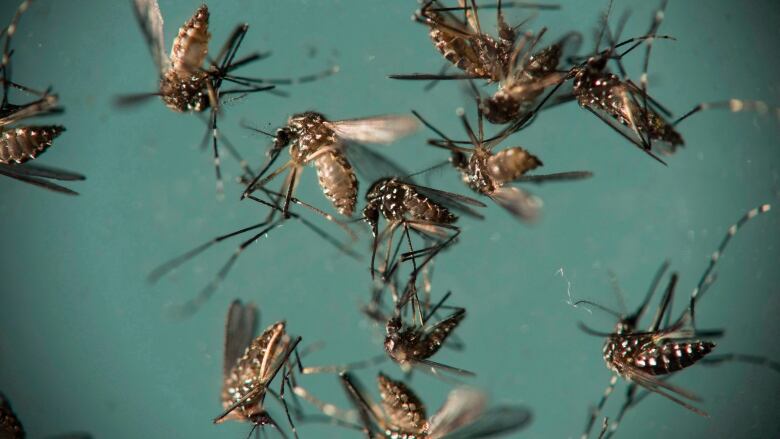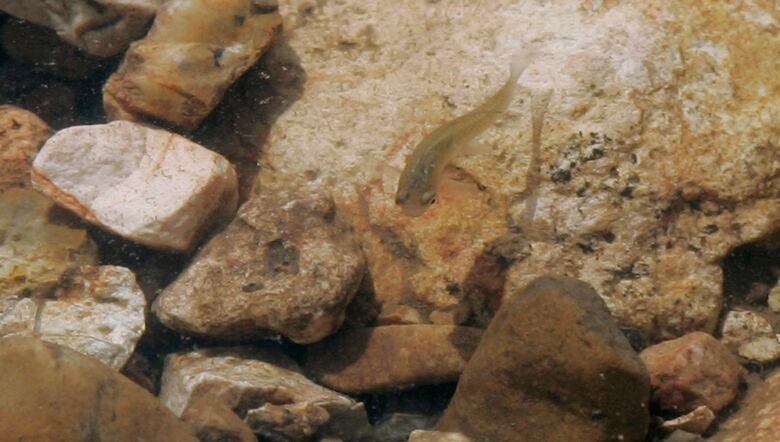Winnipeg has looked to minnows, bug bombs and flowers in decades of mosquito fighting
'50s and '60s were marked by clouds of toxic DDT fog; so far this year, ' you won't be chased into your house'

The annual struggle against Winnipeg's summer scourge of mosquitoes has led to a colourful history of peculiar and sometimes dangerousmethods of trying to control them.
From minnows and dragonfly nymphs todetergent and chrysanthemum extracts, the city has explored a range oftechniques and is always on the lookout for more.
"The insect control branch has been in operation nearly 100 years and we've really evolved," said Ken Nawolsky, superintendent of insect control for the City of Winnipeg.
"It's a process where you test things out and see if they work, and if not then you move on to other ideas. But it makes it very interesting."
But one of the earliest approaches still makesNawolskyshake his head.

In the 1950s and '60s, DDT an insecticidenow banned in Canada was sprayed from trucks, airplanes, and boats,shrouding neighbourhoods in toxic clouds.
There are photographs in the city archives of crews wearing no protection as the fog engulfs them.
"It's quite eye-opening and I'm glad we don't do things like what was done in the past," Nawolsky said. "We're trying to protect our planet and using the best products and safest products that are out there."
DDT
Dichlorodiphenyltrichloroethanewas an effective insecticide but went too far.
It causedthe thinning of eggshells of birds, damaged their reproductive abilities and nearly wiped out populations of peregrine falcons andeagles. It was alsohighly toxic to aquatic animals, affecting the heart and brain.
In 1962, author Rachel Carson'sSilent Springsounded alarms about the chemical and by 1969, the Metropolitan Corporation of Greater Winnipeg approved a reportrecommending its ban.
Minnows
On May 23, 1958, 50 minnows were placed in a pond in King's Park to feed on mosquito larvae, according to a 1959 report of theGreater Winnipeg Mosquito Abatement District. By November, there were several thousand.
About 1,000 were taken from the pond in the fall and transferred to a trout hatchery at Caddy Lake for the winter. None survived there but a few did at the pond. Eight more ponds were stocked and the report optimistically noted "we intend to place more in other ponds."

In the end, though, the minnows didn't survive, said Nawolsky.
"It's unfortunately something that's not realistic in our environment."
Mosquito bombs
The city sprays ditches and other areas of standing water aspart of a larvicideoperation to killmosquitoes before they hatch. It targets7,000 sites in and just outside the city.
In the 1950s, so-called "mosquito bombs" wereused. Capsules containinga mixture of DDT and lindane an insecticide that has been used againstlice and scabieswere dropped into the water. They were costly, though, and failed to rupture on time and evenly disperse, according to the city.
They also killed natural mosquito predators like dragonflies. Now, the city uses abiological larvicidethat leaves other insects unharmed.
Dragonflies
Around 2008, the city attempted a dragonfly breeding program, relocatingnymphs to water bodies that tendto have large numbers of mosquito larvae.
It turned out the nymphs relied on their specific habitats, and moving themcaused many to die.

"We found the best thing is just leave it to Mother Nature. Dragonflies will know where to breed and increase their population," Nawolsky said.
Even so, dragonflies are not the ultimate knockout blow. For them, mosquitoes are a snack. They preferlarger insects like moths,one of which is equivalent to 100 mosquitoes, saidNawolsky.
Chrysanthemums
A pesticide found naturally in some chrysanthemum flowers has been used to create a spray mixture toxic to mosquitoes.
"It's part of the chemical composition of the plant, and whenit's when combined with another product it can be effective in mosquitocontrol. It affects the nervous system of the mosquito," said Nawolsky.
The idea a mass planting ofchrysanthemums around the city to combat mosquitoes sounds nice, but it would be ineffective,Nawolsky said.
"Chrysanthemumplants by themselves really will not do anything. It's about taking the properties within them."
Those compounds, calledpyrethrins,are mixed with oil and an emulsifier a stabilizer to keepliquids from separating. Such a mixture was used in the 1950s "for quick knockdown of flying mosquitoes, and for a larvicide in the vicinity of cattle and poultry ranches," according to the 1959 city report.
Nawolsky said it was a trial that was never expanded to urban areas such asthe city.
Detergents
In another1959 trial, fourdish detergents were tested in a laboratory for their effectiveness in killing larvae. All worked about the same.
Again, it was never used citywide, but amixture of dish detergent and water in a spay bottle is an easy backyard insecticide, Nawolsky said, adding it works against caterpillars, too.
"Most insects are very susceptible to a soapy water solution. The soap dehydrates their skin so that they can't continue to breathe properly," he said, and the insect dies within minutes.
Malathion
Used in Winnipeg since the 1980s, malathion was declared"probably carcinogenic" to humans by the World Health Organization in 2015 and banned from sale in Canada.
But existing stocks were allowed to be depletedbecause the report left room for doubt. It saidthe findings were based on"limited evidence ofcarcinogenicityin humans for non-Hodgkin lymphoma and prostate cancer."
Winnipegused up the last of its supply in 2016.
Now, the city has come back to chrysanthemums. In 2017, it was given the green light to useDeltaGard, which containsdeltamethrin a synthetic version of a pyrethrin.
Mother Nature
The best defencehowever,has been Mother Nature.
Other than two nights of targeted fogging in somecity parks and cemeteries last year, the cityhasn't fogged since 2016. AndNawolsky says the situation this year is following the same pattern, with the amount of standing water relatively low right now.
"We did get some rain here [over the past week] but it's very manageable for us because we also had a dry May. Thatallowed a lot of the water to start absorbing into the ground," he said, adding crews are also larvicidingnow.
"So we feel confident that in the next few weeks people really won't notice too much more mosquitoes than now. There's the odd one, but you won't be chased into your house."
(PDF KB)
(Text KB)CBC is not responsible for 3rd party content












_(720p).jpg)


 OFFICIAL HD MUSIC VIDEO.jpg)
.jpg)



























































































